Video of the Week: Spider Mites on Tomatoes
Upcoming Events:
https://www.eventbrite.com/e/k-state-flower-field-day-tickets-26105824223
July 30 K-State Research & Extension Center Horticulture
Field Day, Olathe
http://www.johnson.k-state.edu/lawn-garden/horticulture-field-day.html
August 4 Kansas Turfgrass Field Day, Manhattan
https://turffieldday.eventbrite.com
August 15 K-State Vegetable Research Field Day, Olathe
http://hnr.k-state.edu/events/2016%20GG%20Vegetable%20Research%20Tour.pdf
Vegetables:
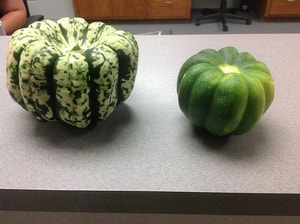
Occasionally we receive a call from someone who has a squash (or cucumber or melon) that just doesn’t look like what was supposedly planted. They often wish to know if that fruit had cross-pollinated with another vegetable close by. In such cases, the gardener is assuming that cross-pollination will affect the fruit. Such is not the case. The characteristics of the fruit is determined by the mother plant and is not affected by
cross-pollination. However, there will be a problem if seed is saved for the next year from a flower that was cross-pollinated. All bets are off on what you will get if that happens.
So, how do we end up with this weird fruit? Though it could be that the gardener had forgotten exactly what he planted, more likely is that the seed he planted had been cross-pollinated before packaging. Another possibility is that it came from seed that came from fruit that had rotted in the garden the previous year. Regardless, don’t worry about planting different cultivars of squash or cucumbers or melons close to one another. Though cross-pollination may occur, the fruit will not be affected. (Ward Upham)
Pests:
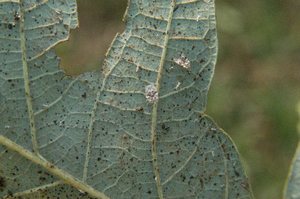
We often associate lace bugs with sycamores and cotoneaster, but oaks can be affected as well. Actually, the lace bugs that affect these three plants are separate species. Lace bugs are true bugs and therefore feed by sucking sap through straw-like mouthparts that pierce the leaf. These three species also are similar in appearance due to the lacy quality of the wings that lie flat over the back.
Though lace bugs are found on the bottom of leaves, the symptoms will become apparent on top. Damage appears as a stippling effect from white to yellow spots. From a distance, the oak leaves often appear bronze. Even if you don't find living specimens, their presence is given away by small, shiny dark spots of excrement on the undersides of leaves.
Lace bugs normally do not cause significant damage to oaks, and control measures are usually not recommended. However, contact insecticides can be used for control in extreme cases. Direct the spray under the leaf where the lace bugs feed. (Ward Upham)
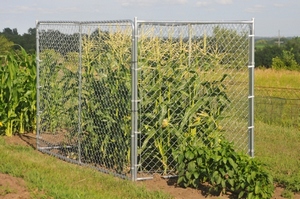
It seems the official sweet corn inspector should be the raccoon as they seem to harvest the sweet corn the day before it is to be picked. The only effective control measure I have had success with is fencing; either electric or kennel fencing. Here are some suggestions for electric fencing based on my experience. Other designs may very well work but this is what has worked in my garden.
– Two or more wires must be used. Place the first about 5 inches above the ground and the second 4 inches above the first (or 9 inches above ground). Raccoons must not be able to crawl under, go between or go over the wires without being shocked.
– Fence posts used for electric fences work well for this application (go figure), as do the insulators used to support the electric wire.
– It is much easier to use the woven electric wire with strands of wire embedded than to use a solid metal wire. The woven wire is easier to bend around corners and to roll up when done for the year.
– Though both the plug-in and battery operated fencers work, the battery operated types allow more versatility in where corn is grown. One set of batteries is usually sufficient for the season. In my case, I pull the battery out of an old tractor that is not used often. It will also last the season if fully charged at the beginning. My fencer is probably on for a total of a month.
– Start the charger before the corn is close to being ripe. Once raccoons get a taste of the corn, they are more difficult to discourage.
– Control weeds near the wire. Weeds can intercept the voltage if they touch a wire and allow raccoons entry beyond the weed.
– Check the wire occasionally to make sure you have current. This can be done easily (but unpleasantly)
by touching the wire. There are also tools that will measure the voltage available for sale. They are worth the money.
As mentioned earlier, kennel fencing can also be used. Make sure that the panels are tied together well enough that raccoons can’t squeeze through corners. (Ward Upham)
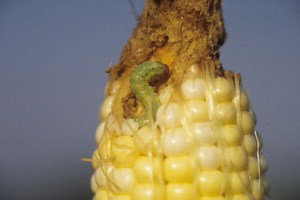
Corn earworm tends to be a problem every year on sweet corn in Kansas. The earworm moth lays eggs on developing silks at night. When the egg hatches, the larva crawls down the silk and into the ear. Feeding starts at the tip of the ear and works down. Though several earworms may hatch and attack a single ear, only one is usually present at harvest due to the cannibalistic nature of the insect. Control is challenging as silks continue to grow over a period of time. This means that even if silks are treated, new silk will appear that hasn't been protected. Applications every 2 to 3 days are needed for insecticides to be effective, especially in late
June to early July when peak flight of these moths usually appear.
There is a three-week period from silking to harvest, but there is only a two-week period from when the
silks appear to when they begin to dry. Since moths prefer juicy silks and shun those that have started to dry, insecticides are only needed the first two weeks of silking.
Homeowners can use cyfluthrin (Baythroid; Bayer Vegetable and Garden Insect Killer) or spinosad (SpinTor; Captain Jack's Dead Bug Brew; Conserve; Borer, Bagworm, Tent Caterpillar & Leafminer Spray). Spinosad is an organic product. Commercial growers have additional choices including
zeta-cypermethrin (Mustang Max), bifenthrin+zeta-cypermethrin (Hero), spinetoram (Radiant) and flubendiamide (Belt).
Though more time consuming, mineral or other light horticultural oils may also be used. The oil is placed inside the silk end of the ear with a medicine dropper (½ to 3/4 of a dropper) after the silks brown. This will coat the earworms already present and likely suffocate them, though some damage to the tip of the ear will likely have occurred. Applying the oil before the silk has browned may interfere with pollination, leading to incompletely filled ears. (Ward Upham)
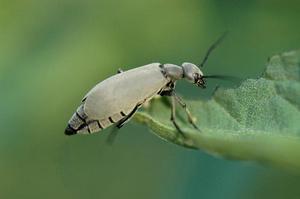
These beetles are notorious for quickly stripping vegetables (especially tomatoes) and ornamentals of their foliage. There are several species of blister beetles which vary in size (often between
0.5-0.75 inch long) and color (such as black, gray or
brown-striped), but most are recognized by their elongated, narrow, cylindrical, soft bodies with middle body part (thorax) narrower than the head or wingcovers.
Some home gardeners like to use hand picking as a nonchemical method for controlling these large insects. However, wear gloves and use caution because these beetles contain a substance called cantharidin. This chemical is an irritant capable of blistering internal and external body tissues exposed to the chemical. On tender human skin, body fluids of adult blister beetles may cause large, erect, watery blisters.
Chemical control of blister beetles is also possible. Cyfluthrin (Bayer Vegetable and Garden Insect Spray) and gamma- or lambda-cyhalothrin (Spectracide Triazicide, Bonide Beetle Killer, Bonide Caterpillar Killer) can be used for control. Cyfluthrin has a 0 day waiting period and lambda-cyhalothrin has a 5-day waiting period on tomatoes. (Ward Upham)
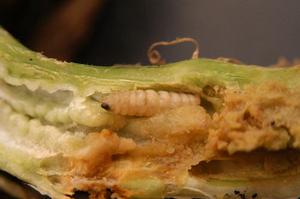
We have received inquiries regarding cucumber and squash plants wilting and collapsing, and a recent visit to the Manhattan Community Garden (Manhattan, KS) provided evidence that the larvae of the squash vine borer (Melittia cucurbitae) are indeed active inside plants. Squash vine borers feed on squash, pumpkin, cucumber, and muskmelon.
Adults are “clear wing” moths 5/8 inches long. The front wings are covered with scales whereas the hind wings are transparent
because they do not have scales. Hind wings have red-brown hairs along the edges. The body is orange-red, with gray bands and three black markings along with orange-red hairs on the abdomen typically located at the base of plants. A single female is capable of producing up to 200 eggs.
Larvae that hatch from eggs are white, with a dark head capsule. Young larvae are 1/4 to 3/4 inches in length and taper toward the end of the abdomen. Mature or fully-grown larvae are 1.0 to 1.5 inches long.
Larvae that hatch from eggs immediately tunnel into the base of plants. The larvae feed for 30 days in the plant stem, and increase in size as they mature. Typically there is only one larva per stem; however, multiple larvae may be present in a single tunnel in the stem. Mature larvae leave plants and burrow into the soil to pupate by constructing brown, silkened cocoons in which they overwinter. Squash vine borer overwinters as a mature larva in the cocoon that is located 1.0 to 2.0 inches in the soil. In early spring, the adult (moth) emerges from the soil. Squash vine borer has one generation in Kansas.
At this point, squash vine borer larvae are feeding within the internal vascular tissues inhibiting the plant’s ability to take-up water and nutrients; consequently, resulting in sudden wilting of vines and
plant collapse. Once the larvae are inside the plant, there is little that can be done to control them or prevent damage. The tunnels inside infested plants are packed with moistened frass (fecal matter). Yellow-green sawdust-like frass can also be found around feeding sites at the base of vines or plants, which will be a direct indication that larvae have entered the plant. Since the larvae are feeding inside the plant there is not much that can be done to kill the larvae; however, there are number of plant protection strategies that can be implemented during the remainder of the growing season, including: sanitation and physical control.
Sanitation: remove and dispose of all wilted plants before the larvae leave and enter the soil. Discard all plant debris such as vines and fruits after harvest.
Physical control: rototilling in fall or spring will directly kill squash vine borer pupae or bring the pupae to the soil surface where they are exposed to cold weather or predation by birds. In addition, the process of deep plowing will bury the pupae deeper in the soil profile thus inhibiting adult emergence. Another technique that may have limited use in large plantings but may be feasible for smaller plantings is to locate infested stems and vines, create slits at the base of the plant, and then use tweezers to remove and destroy the larvae inside. The plant base should then be covered with moist soil, which stimulates
the production of secondary vines and/or root growth; thus helping the plant to re-establish.
There is a new up-dated extension publication on squash vine borer (MF3309) that contains current information on plant protection with images of the insect (both adult and larva) and plant damage. You can download a PDF from the following website:
http://www.bookstore.ksre.ksu.edu/pubs/MF3309.pdf (Raymond Cloyd)
 RSS Feed
RSS Feed
